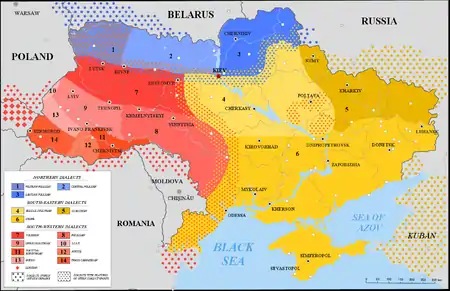Lemkivshchyna
Lemkivshchyna or Lemkovyna (Polish: Łemkowszczyzna; Rusyn: Лемковина/Lemkovyna; Ukrainian: Лемківщина, Lemkivshchyna) is a region in Europe that is traditionally inhabited by the Lemko people. While the Lemko are a distinct ethnic group, they consider themselves to be part of the broader Rusyn and/or Ukrainian communities. Lemkovyna mostly stretches along the border between Poland and Slovakia covering some western territories of Ukraine.



The region forms an ethnographic peninsula 140 km (87 mi) long and 25–50 km (16–31 mi) wide from the Ukrainian border within Polish and Slovak territory. The Lemko region occupies the lowest part of the Ukrainian Carpathian Mountains—most of the Low Beskids, the western part of the Middle Beskyd, and the eastern fringe of the Western Beskyd. It includes the higher elevations of the Carpathians of modern-day Poland, extending to around the Poprad River to the west (see: Ruś Szlachtowska), and extending to the east as far as the region around Sanok, where it meets the Boyko region. The corresponding latitudes of the adjacent highlands of present-day Slovakia are also included by some in the description of Lemko-land.
Previously a frontier area under the nominal control of Great Moravia, Lemkivshchyna became part of Poland in medieval Piast times. It was made part of the Austrian province of Galicia due to the First Partition of Poland in 1772.[1] Parts were briefly independent under the Lemko-Rusyn Republic and Komancza Republic, and later annexed to Poland.
After the deportation of Lemkos from the northern part of this area in 1946, only the southern section, southwest of the Carpathian Mountains, known as the Prešov region in Slovakia, has remained inhabited by Lemkos.
The landscape is typical of medium-height-mountain terrain, with ridges reaching 1,000 m (3,300 ft) and sometimes 1,300 m (4,300 ft). Only small parts of southern Low Beskids and the northern San river region have a low-mountain landscape. A series of mountain passes along the Torysa River and Poprad River—Tylych Pass (688 m (2,257 ft)), Dukla Pass (502 m (1,647 ft)), and Łupków Pass (657 m (2,156 ft))—facilitate communications between Galician and Transcarpathian Lemkos.
Publications
- "Łemkowie Grupa Etniczna czy Naród"?, [The Lemkos: An Ethnic Group or a Nation?], trans. Paul J. Best
- "The Lemkos of Poland" - Articles and Essays, editor Paul Best and Jarosław Moklak
- "The Lemko Region, 1939–1947 War, Occupation and Deportation" - Articles and Essays, editor Paul Best and Jarosław Moklak, ISBN 978-1938292033 (avail. from: Inter-Ed, Inc, New Haven, CT)
See also
References
- Levinson, David (1994). Friedrich, Paul; Levinson, David (eds.). Encyclopedia of World Cultures: Russia and Eurasia, China. Encyclopedia of World Cultures. 6. Boston, Massachusetts: G. K. Hall. p. 69. ISBN 978-0-8161-1810-6.
_..jpg.webp)
